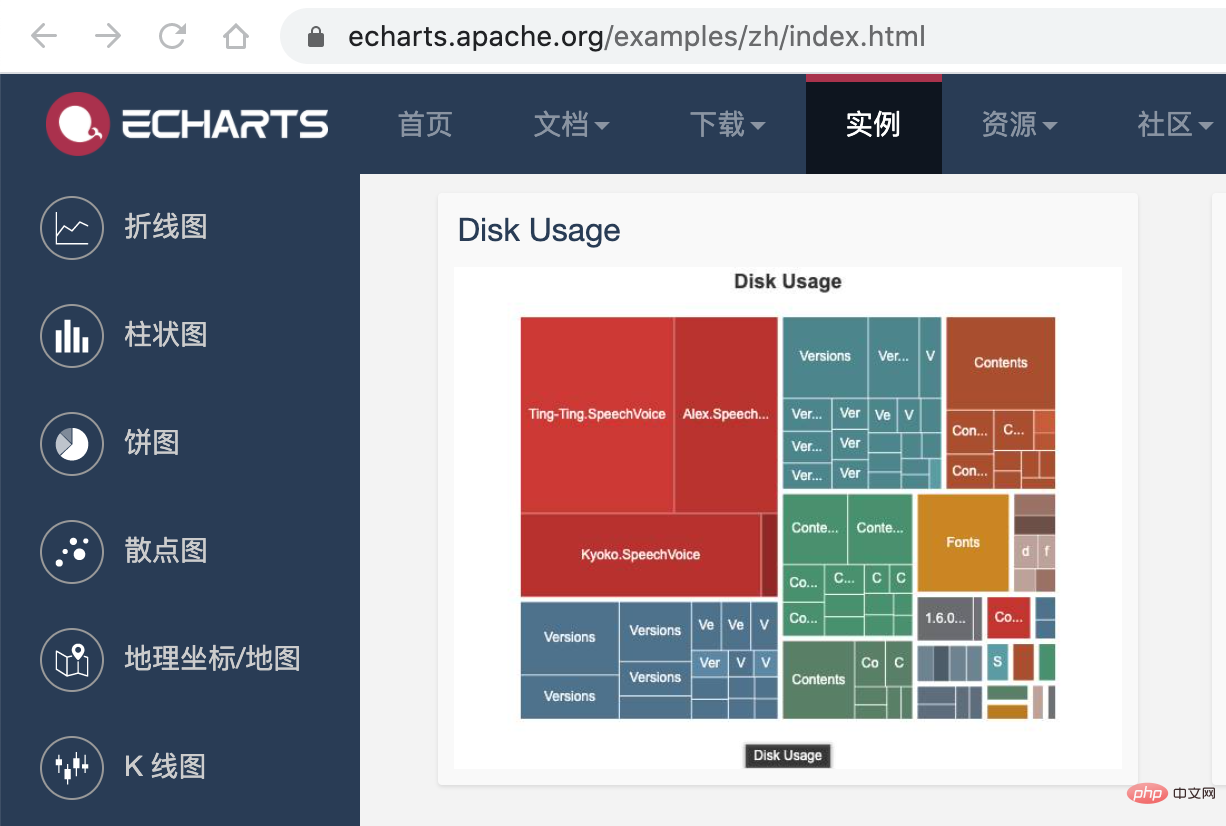
用過 webpack 的同學肯定知道介紹小程式依賴分析實踐,可以用來分析目前專案 js 檔案的依賴關係。

因為最近一直在做小程式業務,而且小程式對包體大小特別敏感,所以就想著能不能做一個類似的工具,用來查看當前小程式各個主包與分包之間的依賴關係。經過幾天的折騰終於做出來了,效果如下:

今天的文章就帶大家來實現這個工具。
小程式的頁面透過app.json的pages參數定義,用於指定小程式由哪些頁面組成,每一項都對應一個頁面的路徑(含檔案名稱) 資訊。pages內的每個頁面,小程式都會去尋找對應的json,js,wxml,wxss四個文件進行處理。
如開發目錄為:
├── app.js ├── app.json ├── app.wxss ├── pages │ │── index │ │ ├── index.wxml │ │ ├── index.js │ │ ├── index.json │ │ └── index.wxss │ └── logs │ ├── logs.wxml │ └── logs.js └── utils复制代码
則需要在app.json 中寫:
{ "pages": ["pages/index/index", "pages/logs/logs"] }复制代码
為了方便演示,我們先fork 一份小程式的官方demo,然後新建一個檔案depend.js,依賴分析相關的工作就在這個檔案裡面實作。
$ git clone git@github.com:wechat-miniprogram/miniprogram-demo.git $ cd miniprogram-demo $ touch depend.js复制代码
其大致的目錄結構如下:

#以app.json為入口,我們可以取得所有主套件下的頁面。
const fs = require('fs-extra')const path = require('path')const root = process.cwd()class Depend { constructor() { this.context = path.join(root, 'miniprogram') } // 获取绝对地址 getAbsolute(file) { return path.join(this.context, file) } run() { const appPath = this.getAbsolute('app.json') const appJson = fs.readJsonSync(appPath) const { pages } = appJson // 主包的所有页面 } }复制代码
每個頁面會對應json,js,wxml,wxss四個檔案:
const Extends = ['.js', '.json', '.wxml', '.wxss']class Depend { constructor() { // 存储文件 this.files = new Set() this.context = path.join(root, 'miniprogram') } // 修改文件后缀 replaceExt(filePath, ext = '') { const dirName = path.dirname(filePath) const extName = path.extname(filePath) const fileName = path.basename(filePath, extName) return path.join(dirName, fileName + ext) } run() { // 省略获取 pages 过程 pages.forEach(page => { // 获取绝对地址 const absPath = this.getAbsolute(page) Extends.forEach(ext => { // 每个页面都需要判断 js、json、wxml、wxss 是否存在 const filePath = this.replaceExt(absPath, ext) if (fs.existsSync(filePath)) { this.files.add(filePath) } }) }) } }复制代码
現在pages 內頁面相關的檔案都放到files 欄位存起來了。
拿到檔案後,我們需要依據個別檔案建構一個樹狀結構的檔案樹,用於後續展示依賴關係。
假設我們有一個pages目錄,pages目錄下有兩個頁面:detail、index,這兩個頁面資料夾下有四個對應的檔案。
pages ├── detail │ ├── detail.js │ ├── detail.json │ ├── detail.wxml │ └── detail.wxss └── index ├── index.js ├── index.json ├── index.wxml └── index.wxss复制代码
依據上面的目錄結構,我們建構一個如下的檔案樹結構,size用來表示目前檔案或資料夾的大小,children存放資料夾下的文件,如果是文件則沒有children屬性。
pages = { "size": 8, "children": { "detail": { "size": 4, "children": { "detail.js": { "size": 1 }, "detail.json": { "size": 1 }, "detail.wxml": { "size": 1 }, "detail.wxss": { "size": 1 } } }, "index": { "size": 4, "children": { "index.js": { "size": 1 }, "index.json": { "size": 1 }, "index.wxml": { "size": 1 }, "index.wxss": { "size": 1 } } } } }复制代码
我們先在建構子建構一個tree欄位用來儲存檔案樹的數據,然後我們將每個檔案傳入addToTree方法,將文件添加到樹中。
class Depend { constructor() { this.tree = { size: 0, children: {} } this.files = new Set() this.context = path.join(root, 'miniprogram') } run() { // 省略获取 pages 过程 pages.forEach(page => { const absPath = this.getAbsolute(page) Extends.forEach(ext => { const filePath = this.replaceExt(absPath, ext) if (fs.existsSync(filePath)) { // 调用 addToTree this.addToTree(filePath) } }) }) } }复制代码
接下來實作addToTree方法:
class Depend { // 省略之前的部分代码 // 获取相对地址 getRelative(file) { return path.relative(this.context, file) } // 获取文件大小,单位 KB getSize(file) { const stats = fs.statSync(file) return stats.size / 1024 } // 将文件添加到树中 addToTree(filePath) { if (this.files.has(filePath)) { // 如果该文件已经添加过,则不再添加到文件树中 return } const size = this.getSize(filePath) const relPath = this.getRelative(filePath) // 将文件路径转化成数组 // 'pages/index/index.js' => // ['pages', 'index', 'index.js'] const names = relPath.split(path.sep) const lastIdx = names.length - 1 this.tree.size += size let point = this.tree.children names.forEach((name, idx) => { if (idx === lastIdx) { point[name] = { size } return } if (!point[name]) { point[name] = { size, children: {} } } else { point[name].size += size } point = point[name].children }) // 将文件添加的 files this.files.add(filePath) } }复制代码
我們可以在運行之後,將檔案輸出到介紹小程式依賴分析實踐看看。
run() { // ... pages.forEach(page => { //... }) fs.writeJSONSync('介紹小程式依賴分析實踐', this.tree, { spaces: 2 }) }复制代码

上面的步驟看起來沒什麼問題,但是我們缺少了重要的一環,那就是我們在建構檔樹之前,還需要得到每個檔案的依賴項,這樣輸出的才是小程式完整的檔案樹。檔案的依賴關係需要分成四個部分來講,分別是js,json,wxml,wxss這四種類型檔案擷取依賴的方式。
小程式支援 CommonJS 的方式進行模組化,如果開啟了 es6,也能支援 ESM 進行模組化。我們如果要獲得一個js檔案的依賴,首先要明確,js 檔案匯入模組的三種寫法,針對下面三種語法,我們可以引入 Babel 來取得依賴。
import a from './a.js'export b from './b.js'const c = require('./c.js')复制代码
透過@babel/parser將程式碼轉換為AST,然後透過@babel/traverse遍歷AST 節點,取得上面三種導入方式的值,放到數組。
const { parse } = require('@babel/parser')const { default: traverse } = require('@babel/traverse')class Depend { // ... jsDeps(file) { const deps = [] const dirName = path.dirname(file) // 读取 js 文件内容 const content = fs.readFileSync(file, 'utf-8') // 将代码转化为 AST const ast = parse(content, { sourceType: 'module', plugins: ['exportDefaultFrom'] }) // 遍历 AST traverse(ast, { ImportDeclaration: ({ node }) => { // 获取 import from 地址 const { value } = node.source const jsFile = this.transformScript(dirName, value) if (jsFile) { deps.push(jsFile) } }, ExportNamedDeclaration: ({ node }) => { // 获取 export from 地址 const { value } = node.source const jsFile = this.transformScript(dirName, value) if (jsFile) { deps.push(jsFile) } }, CallExpression: ({ node }) => { if ( (node.callee.name && node.callee.name === 'require') && node.arguments.length >= 1 ) { // 获取 require 地址 const [{ value }] = node.arguments const jsFile = this.transformScript(dirName, value) if (jsFile) { deps.push(jsFile) } } } }) return deps } }复制代码
在獲取依賴模組的路徑後,還不能立即將路徑添加到依賴數組內,因為根據模組語法js後綴是可以省略的,另外require 的路徑是一個文件夾的時候,預設會導入該資料夾下的index.js。
class Depend { // 获取某个路径的脚本文件 transformScript(url) { const ext = path.extname(url) // 如果存在后缀,表示当前已经是一个文件 if (ext === '.js' && fs.existsSync(url)) { return url } // a/b/c => a/b/c.js const jsFile = url + '.js' if (fs.existsSync(jsFile)) { return jsFile } // a/b/c => a/b/c/index.js const jsIndexFile = path.join(url, 'index.js') if (fs.existsSync(jsIndexFile)) { return jsIndexFile } return null } jsDeps(file) {...} }复制代码
我們可以建立一個js,看看輸出的deps是否正確:
// 文件路径:/Users/shenfq/Code/fork/miniprogram-demo/import a from './a.js'export b from '../b.js'const c = require('../../c.js')复制代码

json文件本身是不支持模块化的,但是小程序可以通过json文件导入自定义组件,只需要在页面的json文件通过usingComponents进行引用声明。usingComponents为一个对象,键为自定义组件的标签名,值为自定义组件文件路径:
{ "usingComponents": { "component-tag-name": "path/to/the/custom/component" } }复制代码
自定义组件与小程序页面一样,也会对应四个文件,所以我们需要获取json中usingComponents内的所有依赖项,并判断每个组件对应的那四个文件是否存在,然后添加到依赖项内。
class Depend { // ... jsonDeps(file) { const deps = [] const dirName = path.dirname(file) const { usingComponents } = fs.readJsonSync(file) if (usingComponents && typeof usingComponents === 'object') { Object.values(usingComponents).forEach((component) => { component = path.resolve(dirName, component) // 每个组件都需要判断 js/json/wxml/wxss 文件是否存在 Extends.forEach((ext) => { const file = this.replaceExt(component, ext) if (fs.existsSync(file)) { deps.push(file) } }) }) } return deps } }复制代码
wxml 提供两种文件引用方式import和include。
复制代码
wxml 文件本质上还是一个 html 文件,所以可以通过 html parser 对 wxml 文件进行解析,关于 html parser 相关的原理可以看我之前写过的文章 《Vue 模板编译原理》。
const htmlparser2 = require('htmlparser2')class Depend { // ... wxmlDeps(file) { const deps = [] const dirName = path.dirname(file) const content = fs.readFileSync(file, 'utf-8') const htmlParser = new htmlparser2.Parser({ onopentag(name, attribs = {}) { if (name !== 'import' && name !== 'require') { return } const { src } = attribs if (src) { return } const wxmlFile = path.resolve(dirName, src) if (fs.existsSync(wxmlFile)) { deps.push(wxmlFile) } } }) htmlParser.write(content) htmlParser.end() return deps } }复制代码
最后 wxss 文件导入样式和 css 语法一致,使用@import语句可以导入外联样式表。
@import "common.wxss";复制代码
可以通过postcss解析 wxss 文件,然后获取导入文件的地址,但是这里我们偷个懒,直接通过简单的正则匹配来做。
class Depend { // ... wxssDeps(file) { const deps = [] const dirName = path.dirname(file) const content = fs.readFileSync(file, 'utf-8') const importRegExp = /@import\\s*['"](.+)['"];*/g let matched while ((matched = importRegExp.exec(content)) !== null) { if (!matched[1]) { continue } const wxssFile = path.resolve(dirName, matched[1]) if (fs.existsSync(wxmlFile)) { deps.push(wxssFile) } } return deps } }复制代码
现在我们需要修改addToTree方法。
class Depend { addToTree(filePath) { // 如果该文件已经添加过,则不再添加到文件树中 if (this.files.has(filePath)) { return } const relPath = this.getRelative(filePath) const names = relPath.split(path.sep) names.forEach((name, idx) => { // ... 添加到树中 }) this.files.add(filePath) // ===== 获取文件依赖,并添加到树中 ===== const deps = this.getDeps(filePath) deps.forEach(dep => { this.addToTree(dep) }) } }复制代码

熟悉小程序的同学肯定知道,小程序提供了分包机制。使用分包后,分包内的文件会被打包成一个单独的包,在用到的时候才会加载,而其他的文件则会放在主包,小程序打开的时候就会加载。subpackages中,每个分包的配置有以下几项:
| 字段 | 类型 | 说明 |
|---|---|---|
| root | String | 分包根目录 |
| name | String | 分包别名,分包预下载时可以使用 |
| pages | StringArray | 分包页面路径,相对与分包根目录 |
| independent | Boolean | 分包是否是独立分包 |
所以我们在运行的时候,除了要拿到pages下的所有页面,还需拿到subpackages中所有的页面。由于之前只关心主包的内容,this.tree下面只有一颗文件树,现在我们需要在this.tree下挂载多颗文件树,我们需要先为主包创建一个单独的文件树,然后为每个分包创建一个文件树。
class Depend { constructor() { this.tree = {} this.files = new Set() this.context = path.join(root, 'miniprogram') } createTree(pkg) { this.tree[pkg] = { size: 0, children: {} } } addPage(page, pkg) { const absPath = this.getAbsolute(page) Extends.forEach(ext => { const filePath = this.replaceExt(absPath, ext) if (fs.existsSync(filePath)) { this.addToTree(filePath, pkg) } }) } run() { const appPath = this.getAbsolute('app.json') const appJson = fs.readJsonSync(appPath) const { pages, subPackages, subpackages } = appJson this.createTree('main') // 为主包创建文件树 pages.forEach(page => { this.addPage(page, 'main') }) // 由于 app.json 中 subPackages、subpackages 都能生效 // 所以我们两个属性都获取,哪个存在就用哪个 const subPkgs = subPackages || subpackages // 分包存在的时候才进行遍历 subPkgs && subPkgs.forEach(({ root, pages }) => { root = root.split('/').join(path.sep) this.createTree(root) // 为分包创建文件树 pages.forEach(page => { this.addPage(`${root}${path.sep}${page}`, pkg) }) }) // 输出文件树 fs.writeJSONSync('介紹小程式依賴分析實踐', this.tree, { spaces: 2 }) } }复制代码
addToTree方法也需要进行修改,根据传入的pkg来判断将当前文件添加到哪个树。
class Depend { addToTree(filePath, pkg = 'main') { if (this.files.has(filePath)) { // 如果该文件已经添加过,则不再添加到文件树中 return } let relPath = this.getRelative(filePath) if (pkg !== 'main' && relPath.indexOf(pkg) !== 0) { // 如果该文件不是以分包名开头,证明该文件不在分包内, // 需要将文件添加到主包的文件树内 pkg = 'main' } const tree = this.tree[pkg] // 依据 pkg 取到对应的树 const size = this.getSize(filePath) const names = relPath.split(path.sep) const lastIdx = names.length - 1 tree.size += size let point = tree.children names.forEach((name, idx) => { // ... 添加到树中 }) this.files.add(filePath) // ===== 获取文件依赖,并添加到树中 ===== const deps = this.getDeps(filePath) deps.forEach(dep => { this.addToTree(dep) }) } }复制代码
这里有一点需要注意,如果package/a分包下的文件依赖的文件不在package/a文件夹下,则该文件需要放入主包的文件树内。
经过上面的流程后,最终我们可以得到如下的一个 json 文件:

接下来,我们利用 介紹小程式依賴分析實踐 的画图能力,将这个 json 数据以图表的形式展现出来。我们可以在 介紹小程式依賴分析實踐 提供的实例中看到一个 Disk Usage 的案例,很符合我们的预期。

介紹小程式依賴分析實踐 的配置这里就不再赘述,按照官网的 demo 即可,我们需要把tree. json的数据转化为 介紹小程式依賴分析實踐 需要的格式就行了,完整的代码放到 codesandbod 了,去下面的线上地址就能看到效果了。
线上地址:https://codesandbox.io/s/cold-dawn-kufc9

这篇文章比较偏实践,所以贴了很多的代码,另外本文对各个文件的依赖获取提供了一个思路,虽然这里只是用文件树构造了一个这样的依赖图。
在业务开发中,小程序 IDE 每次启动都需要进行全量的编译,开发版预览的时候会等待较长的时间,我们现在有文件依赖关系后,就可以只选取目前正在开发的页面进行打包,这样就能大大提高我们的开发效率。如果有对这部分内容感兴趣的,可以另外写一篇文章介绍下如何实现。
相关免费学习推荐:微信小程序开发教程
以上是介紹小程式依賴分析實踐的詳細內容。更多資訊請關注PHP中文網其他相關文章!



